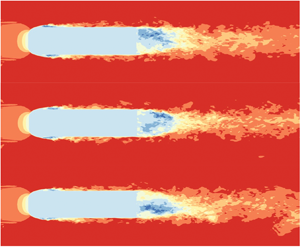Crossref Citations
This article has been cited by the following publications. This list is generated based on data provided by
Crossref.
He, Kan
Minelli, Guglielmo
Su, Xinchao
Gao, Guangjun
and
Krajnović, Siniša
2021.
Influence of the rounded rear edge on wake bi-stability of a notchback bluff body.
Physics of Fluids,
Vol. 33,
Issue. 11,
Podvin, Bérengère
Pellerin, Stéphanie
Fraigneau, Yann
Bonnavion, Guillaume
and
Cadot, Olivier
2022.
Relationship between the base pressure and the velocity in the near-wake of an Ahmed body.
Physical Review Fluids,
Vol. 7,
Issue. 5,
Edwige, Stéphie
Gilotte, Philippe
and
Mortazavi, Iraj
2022.
Computational Analysis of Actuation Techniques Impact on the Flow Control around the Ahmed Body.
Fluids,
Vol. 7,
Issue. 2,
p.
52.
Hesse, Faron
and
Morgans, Aimee S.
2023.
Characterization of the Unsteady Wake Aerodynamics for an Industry Relevant Road Vehicle Geometry Using LES.
Flow, Turbulence and Combustion,
Vol. 110,
Issue. 4,
p.
855.
Keirsbulck, Laurent
Cadot, Olivier
Basley, Jérémy
and
Lippert, Marc
2023.
Base suction, entrainment flux, and wake modes in the vortex formation region at the rear of a three-dimensional blunt bluff body.
Physical Review E,
Vol. 108,
Issue. 1,
Su, Xinchao
He, Kan
Xu, Kewei
Gao, Guangjun
and
Krajnović, Siniša
2023.
Comparison of flow characteristics behind squareback bluff-bodies with and without wheels.
Physics of Fluids,
Vol. 35,
Issue. 3,
Chen, Guang
Li, Xiao-Bai
He, Kan
Cheng, Zhi
Zhou, Dan
and
Liang, Xi-Feng
2023.
Effect of the free-stream turbulence on the bi-modal wake dynamics of square-back bluff body.
Physics of Fluids,
Vol. 35,
Issue. 1,
Khan, T.I.
Parezanović, V.
and
Afgan, I.
2023.
Capturing the bi-stable asymmetry exchanges in the turbulent air wake of a simplified frigate using Large Eddy Simulation.
International Journal of Heat and Fluid Flow,
Vol. 104,
Issue. ,
p.
109233.
Fan, Yajun
and
Cadot, Olivier
2023.
Reynolds number effect on the bistable dynamic of a blunt-base bluff body.
Physical Review E,
Vol. 107,
Issue. 2,
Darabasz, T.
Bonnavion, G.
Cadot, O.
Goraguer, Y.
and
Borée, J.
2023.
Drag reduction using longitudinal vortices on a flat-back Ahmed body.
Experiments in Fluids,
Vol. 64,
Issue. 1,
Podvin, B.
and
Fraigneau, Y.
2024.
Low-dimensional analysis and modelling of the flow over a forward-facing step.
Journal of Fluid Mechanics,
Vol. 1000,
Issue. ,
Chen, C.W.
Wang, S.
and
Ghaemi, S.
2024.
Spectral proper orthogonal decomposition of time-resolved three-dimensional flow measurements in the turbulent wake of the Ahmed body.
Journal of Fluid Mechanics,
Vol. 985,
Issue. ,
Yin, Guang
and
Ong, Muk Chen
2025.
A physics-informed neural network framework with reduced order model for predicting flow-induced vibration.
Results in Engineering,
Vol. 28,
Issue. ,
p.
107728.
Chen, Guang
Wang, Kaiwen
Xue, Rudai
Li, Xiaobai
Liang, Xifeng
and
Wang, Hanfeng
2025.
Upstream flow separation is not a triggering factor in wake bi-stability of the square-back Ahmed body.
Physics of Fluids,
Vol. 37,
Issue. 8,
Midya, Samaresh
and
Symon, Sean
2025.
Experimental investigation of a high Reynolds number turbulent wake generated by a vehicle-like bluff body.
Physical Review Fluids,
Vol. 10,
Issue. 8,
Ong, Muk Chen
and
Yin, Guang
2025.
Synergizing machine learning with fluid–structure interaction research: An overview of trends and challenges.
Ocean,
Vol. 1,
Issue. 1,
p.
9470002.
Zhu, Taihang
Rigas, Georgios
and
Morrison, Jonathan F.
2025.
Near wake coherent structures of a turbulent axisymmetric bluff body wake.
International Journal of Heat and Fluid Flow,
Vol. 112,
Issue. ,
p.
109668.
Fan, Yajun
Xia, Chao
Minelli, Guglielmo
Sebben, Simone
and
Cadot, Olivier
2025.
Recirculating flow structures of a square-back Ahmed body at a variable attitude.
Journal of Fluid Mechanics,
Vol. 1023,
Issue. ,
Wallace, C.
Garmory, A.
Gaylard, A.
and
Butcher, D.
2025.
Investigation of the link between vehicle underbody and base unsteady wake aerodynamics.
Journal of Wind Engineering and Industrial Aerodynamics,
Vol. 265,
Issue. ,
p.
106177.

 $Re$) of 10 000 is considered. Using proper orthogonal decomposition (POD), we identify the most energetic modes of the velocity field and build a low-dimensional model based on the first six fluctuating velocity modes capturing the characteristics of the flow dynamics during and between switches. In the absence of noise, the model produces random switches with characteristic time scales in agreement with the simulation and experiments. This chaotic model suggests that random switches are triggered by the increase of the vortex shedding activity. However, the addition of noise results in a better agreement in the temporal spectra of the coefficients between the model and the simulation.
$Re$) of 10 000 is considered. Using proper orthogonal decomposition (POD), we identify the most energetic modes of the velocity field and build a low-dimensional model based on the first six fluctuating velocity modes capturing the characteristics of the flow dynamics during and between switches. In the absence of noise, the model produces random switches with characteristic time scales in agreement with the simulation and experiments. This chaotic model suggests that random switches are triggered by the increase of the vortex shedding activity. However, the addition of noise results in a better agreement in the temporal spectra of the coefficients between the model and the simulation.

